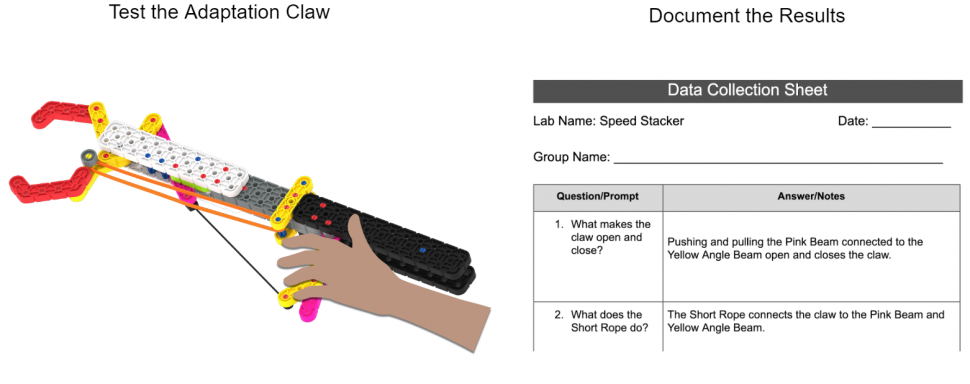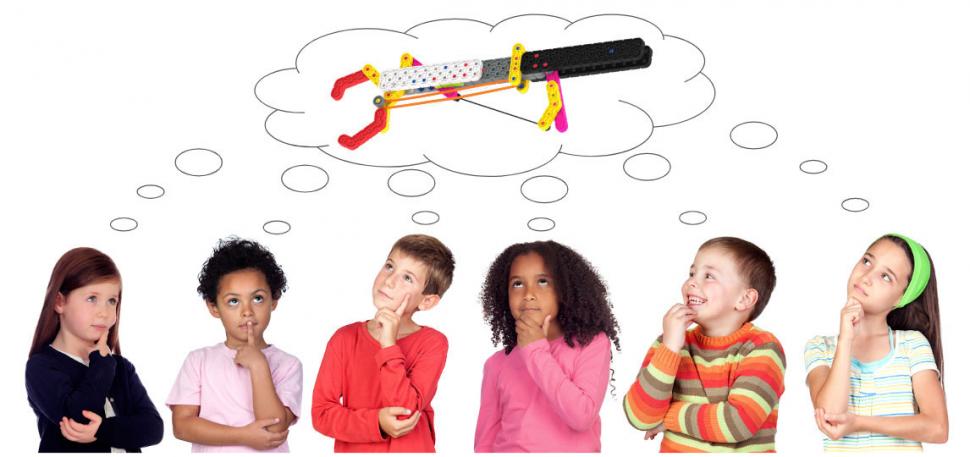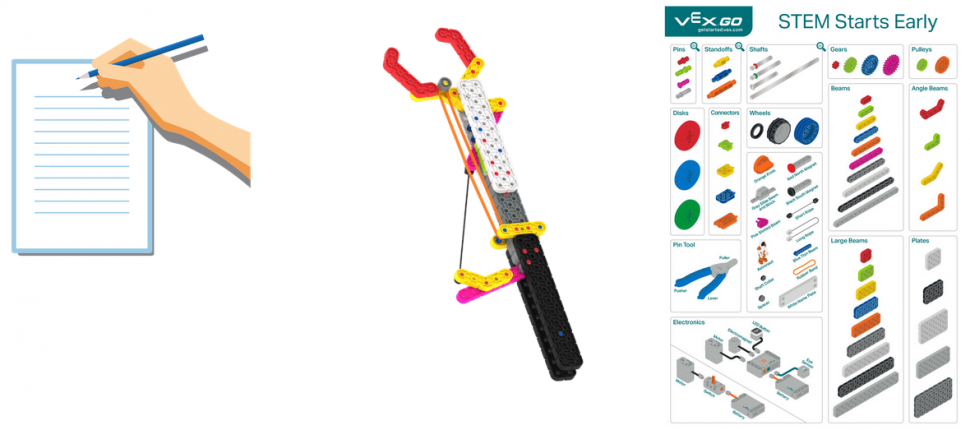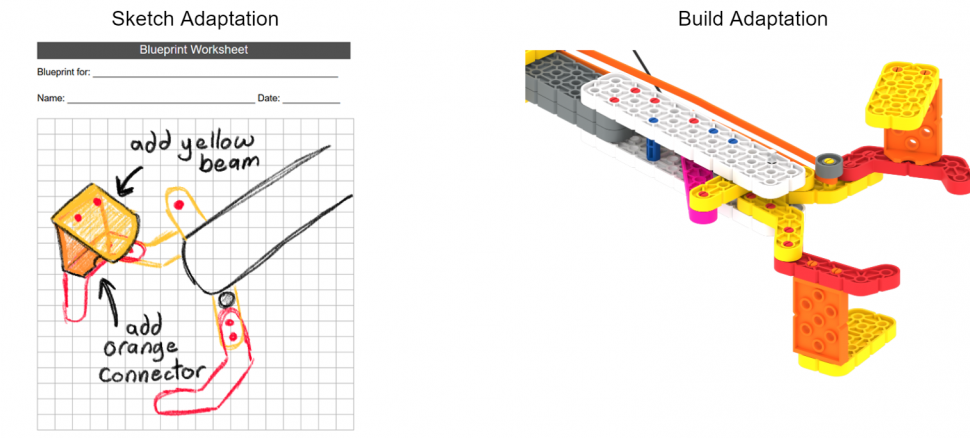Play
Part 1 - Step by Step
- InstructInstruct students that they will begin investigating the Adaptation Claw’s movement. Students will fill out a Data Collection Sheet that contains a list of five different objects to explore how the claw works. Each group should have their sheet and understand its purpose from the Engage section. Distribute five different classroom supplies to each group that they will use to test the functionality of the claw. The classroom supplies should vary in size and shape. The students may drop the objects as they are testing, so ensure the objects are not extremely fragile. Students will begin by ensuring they are in their group and that each group has one sheet, five classroom supplies, and a built Adaptation Claw.

Investigate the Adaptation Claw - ModelModel for students how to test the different objects with the claw by filling out the Data Collection Sheet. Select one object, such as an empty water bottle, as the first object. Model writing the object’s name on the sheet. Use the claw to grab and then lift the object. Document in the second column if grabbing and lifting the object was successful. In the third column, write notes such as, “I had to squeeze harder to grab this object” or “This object was too heavy to lift.” The teacher will demonstrate documenting these findings on the sheet.

Test the Adaptation Claw - FacilitateFacilitate a discussion with the students by asking the following questions as they complete the activity.
- Can you model, using your hands, how the claw grabs one of these objects?
- Were there any objects that surprised you with how easy/hard it was to grab and lift them?
- Do you think the claw picks up lighter or heavier objects better and why?
- Did you have to squeeze the handle harder or softer when lifting any objects?

Discuss the Adaptation Claw - RemindRemind students to record their answers to the questions and prompts on their Data Collection Sheet. Encourage students to write or draw their responses. Remind students to keep trying even when they fail at first. The students will need to test many objects. During testing, students may drop some of the objects as they get used to how to use the claw properly.
- AskAsk students questions such as, “did you drop an object when testing.” If so, how did they work as a group to try again? Ask the students what they learned so far about grabbing and lifting different size and weighted objects. This will help students to foster a growth mindset.
Mid-Play Break & Group Discussion
As soon as every group has accomplished completing their tests and Data Collection Sheet, come together for a brief conversation.
- Could you use the Adaptation Claw to pick up trash on the side of the road? What other situations can you think of where you could use the claw to solve a problem?
- Which items could you pick up easily? Which ones were more challenging?
- For an object that was difficult to pick up, do you think it may have been easier if you could’ve changed something on the Adaptation Claw?
- If you could change the Adaptation Claw to pick up an object that was difficult initially, which VEX GO pieces would you change and why?
Part 2 - Step by Step
- InstructInstruct students that they will identify one object as a group that was difficult to grab and lift. Students can refer to the Data Collection Sheet and their experience in Play Part 1. They should recognize that they have a better understanding of which types of objects are best grabbed and picked up by the Adaptation Claw.
Students will first select an object that was difficult to grab and lift from Play Part 1. Each group will design adaptations to their claw in order to grab and lift the item more efficiently. They will then sketch their ideas for how to better change and adapt the claw, in order to grab and lift the object they chose. To begin, each group will need a Blueprint Worksheet, access to their VEX GO Kits for extra pieces, and their built Adaptation Claw.
Adaptation Materials - ModelModel for students how to sketch a design for their adaptation on their Blueprint Worksheet. Show students how to analyze an object that was difficult to grab and lift, such as a small plastic ball. Then, model how to brainstorm and sketch a new design for the claw that would better grasp and hold the object. For example, adding beams and connectors to the gripper’s design, so that there are more pieces to grab the ball, preventing it from slipping out of the claw’s grasp.

Design Adaptations - FacilitateFacilitate a discussion with the students by asking the following questions as they complete the activity:
- Which object did you choose that was difficult to grab or lift from Play Part 1?
- Can you show me your sketch for the adaptations and explain to me how the VEX GO pieces will be added to the claw?
- Can you explain to me using words such as on top of, below, or next to, where the additional pieces are going on the claw?
- Can you model for me using your hands how the claw will now be able to grab and lift the object better after the pieces are added?
- Did you run into any problems when designing your sketch? Do you have all the pieces you need?
- How is your updated Adaptation Claw supposed to operate?

Discuss the Adaptions - RemindRemind students to brainstorm and sketch their ideas for their adaptations on their Blueprint Worksheet. Encourage students to write or draw their ideas. Remind students to keep trying even when they fail at first. Remind students that their first attempt to change their Adaptation Claw may not work and that is okay. Have a discussion to encourage failure by asking the following:
- What did you try at first?
- How did trying something and it not work, help you to learn?
- What is your new plan to try now?
Students can create new sketches to improve their designs. Students within the group may have different ideas, remind students to give everyone a turn to talk and share their ideas, while others should be listening. Encourage students to compromise on their designs.
- AskAsk students questions to help foster a growth mindset. Examples could include, “if you had the opportunity to design another sketch with unlimited pieces, what would your design be and why?” or “Did you have to compromise or combine ideas at all from multiple people in your group? How did you work together to listen to everyone’s ideas?”
Optional: Teams may deconstruct their Adaptation Claw if needed at this point in the experience. They will use the same build in the subsequent labs, so this is a teacher option.